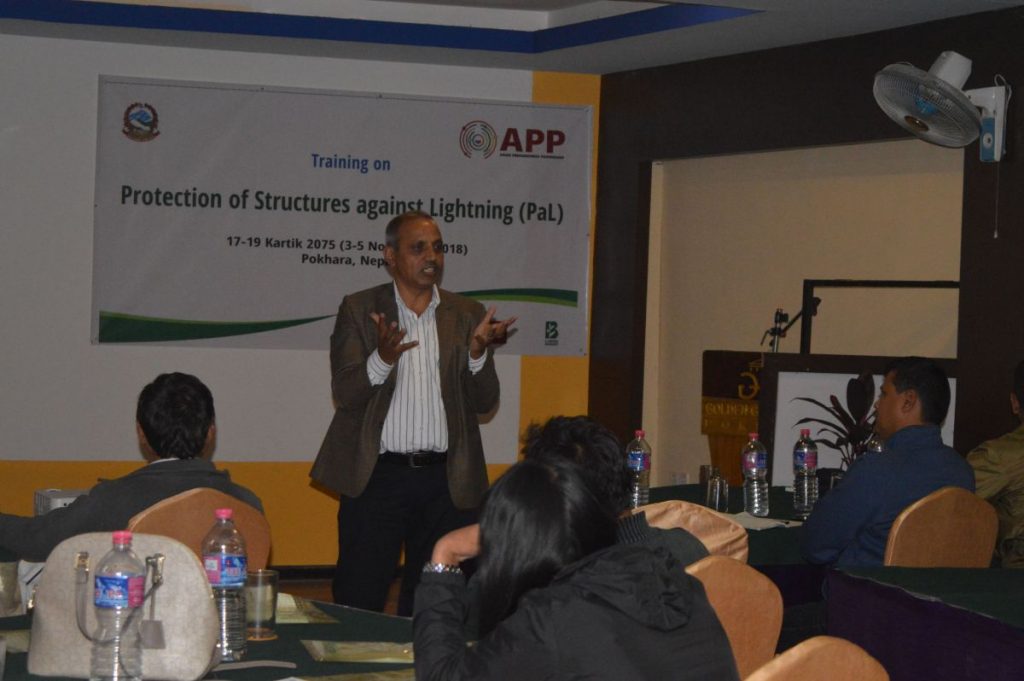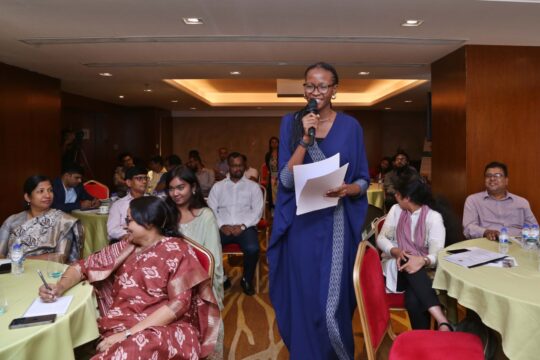The Asian Preparedness Partnership (APP) and the Nepal Preparedness Partnership (NPP) strives to bring all stakeholders against disasters. The organization has united several key players such as the Ministry of Home Affairs (MoHA), province and local governments, NAST, Tribhuvan University, local NGOs, and the private sector for disaster management. The MoHA has enabled the NPP to organize several meetings with key stakeholders. The ministry has also made it possible to review the challenges lightning poses in Nepal, the initiatives and personnel working on PaL, the nature and frequency of lightning across the country, and the activities that can be jointly taken to minimize casualties and property damage.
The NPP took these consultations into consideration when designing the one-day orientation on PaL with the support of NAST and Dr. Shriram. These sessions were initiated in two lightning prone parts of the country through a partnership with the province and local government and private sector. The orientations were geared towards awareness. Feedback from participants and content revision by all stakeholders led to organizing a three-day training on PaL. The redesigned training would include an understanding of lightning, the scientific explanation of its occurrence, the potential damages and threats, and how individuals can protect one another and their property from lightning.

Dr. Shriram developed a training manual following the finalization of the module. The manual and other knowledge products are now used by many development and academic organizations. Such products include posters, videos, PSA, and standard on PaL.
Every Storey Counts
Ajaya Poudei can explain the makings of a building from its foundational structure to its roofline. He has been a project engineer in the construction sector for nearly 40 years, “My experience included construction projects of public, private and government buildings. I was not able to adopt proper lighting systems or add remedy procedures into my process. I sought to enhance my knowledge and professional development for the adequate protection measures that could be applied to the construction sector.” He is bridging the information gap in other parts of his country, “I know that the training I have received can be disseminated and shared in local communities. It is important to share our learnings and build resilience together.”
The engineer admits that he did not consider the weight of lightning systems into his construction plans, “I would take simple measures such as copper wiring, and digging salt pits in proximity to the building. There were no follow-ups on the functionality and effectiveness of these measures.” Ajaya now includes numerous aspects of the lightning protection system into his construction plans, “When we start construction of buildings with the inclusion of the lightning projection systems into each of our plans. We now consider the size and height of the building, surrounding structure, and quality of materials prior to installing the system.”
The PaL training session broadened Ajaya’s conception of installing a proper system, “There were so many parameters that I have not considered when I would install the protection system.” He gained technical knowledge of the system and the external factors that affect it when he attended in 2019: “I can now evaluate the size and strength of a lightning protection system, the proper connection to the ground level for effective external and internal protection of the structure, and the optimal connection points within the structure.”
Ajaya also learned that lightning protection systems must consider specifications that include: the comparative height of the surrounding buildings, and whether the site is a lightning prone area. “The ‘Internal Protection and Bonding’ session was particularly memorable because it applied to the construction sector. It covered the area around the structure that needs to be covered, installation of protection equipment, and the required capacity to minimize and prevent hazardous sparking inside the building or structure.” The engineer found most sessions to be insightful as they detailed coverage of the topic, “My learning experience started with the basics of lightning and its deleterious effects. It continued by covering the need to mainstream disaster risk reduction into development and mechanism for lightning injuries. I came out of the training knowing the necessity of being informed and prepared.”
Teachers are Constant Learners
The PaL training was an opportunity for Sangit Lal Nakarmi, a professor of the Electrical Department of Institute of Engineering, Lamachur, Pokhara, to become a student again, “I took the experience as a way to learn from others who were also concerned about the damages of lightning.” The teachers attended the ‘Protection of Structures against Lightning’ in 2019. He details that the institute has also experienced lightning incidence, “I wanted to keep myself up to date because we have had incidents where lightning has damaged or destroyed a number of our equipment, which includes the telephone lines. I know the training would allow me to incorporate lightning protection in the electrical design of the buildings.”
The teacher has incorporated some of the information from these sessions into his curriculum, “Our students now know how a lightning charge develops in a thundercloud because understanding the nature of lightning is the first step to being prepared. We also teach them about the types of lightning that occur in different countries.” Professor Sangit also emphasizes the need for practical knowledge, “We also have started to teach them about internal lightning protection in buildings and bonding. I have dedicated lectures on Earthing and Lightning Protective Systems in my Industrial Power Distribution and Illumination class.”
Professor Sangit believes in engaging curious minds both inside and outside the classroom, “Dr. Shiriram’s session ability to teach through presentations and interactions make the PaL training extremely engaging. I receive a great number of inquiries because I am from an electrical engineering background. The content from the PaL training put the knowledge in our hands to create a more perceptive community.”
Organizing the training was a collaborative effort that was achieved through NPP’s partnership with MoHA, NAST, local governments, LHOs, and the private sector. There were five training sessions during 2017-2018; these events had a total of 147 attendees from various sectors.



